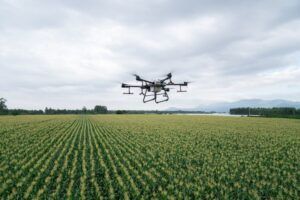At last week’s Salinas Biological Summit in California, multiple speakers and attendees mentioned the need for more efficient trapping systems in the specialty crop arena. Donát Posta and Jimmy Fong, whose company scoutlabs is currently working to digitize such traps for agriculture, just happened to be at the event, too, and sat down with AgFunderNews to discuss the company’s approach to pest management.
The company, formerly known as SMAPP Lab, has developed a hand-held device to aid in the tracking of insect migration and swarming. “Our vision is to build a field-level data-based AI co-pilot that transforms guesswork into data-driven decisions, making agriculture exciting and sustainable for the next generation of farmers,” the company says.
Just recently, scoutlabs announced a $2 million seed round from Interactive Venture Partners , SVG Ventures | THRIVE, DEPO Ventures and Impact Ventures.
Below, Posta and Fong share more about the company’s origins and plans for the future.

AgFunderNews (AFN): Where did the idea to digitize pest management come from?
Donát Posta (DP): My family has a farm [where] we used manual traps to monitor the European corn borer and [other pests] on our sweet corn farm. Doing it manually was almost impossible because we had to hire so many people and the quality of the data they [were] collecting was questionable, so it wasn’t useful for us. There was a large yield loss in one year and I said, OK, how can I help my family?
First I checked for [existing] solutions on the market, but I realized all of them were at minimum 10 times more expensive than our cost on the farm, which was about €100 per trap per season.
That was the point when I decided we could solve the problem [ourselves] turning the entire process to digital, using less labor, better data and better decisions, and only using pesticides when necessary.
Jimmy Fong (JF): That was maybe four years(ish) from the family farm origin. The project started as [Posta’s] university research project. The first iteration was a really nice device and it was more affordable than existing technology — by a bit.
In that part of the world, in Central Europe, there are lots and lots of maize farmers. A year and a half into the project, the learning was that it worked well but the issue was actually around the economics for row crop growers. Because their margins are much less, it’s tricker for them to move to new technology because there’s less to play with in that field.
So our innovation over the last 18 months has been transforming our device.
AFN: How does the technology work?
DP: There are manual pheromone traps on the market, and farmers or agronomists visit these traps two times a week or so.
What we are adding [to the traps] is a very simple camera-based IoT device that takes pictures and sends the pictures to us.
So we’re retrofitting existing traps with this small device and turning the manual traps to digital. It takes pictures each morning, sends the pictures to our server, where we have an image-recognition algorithm that can differentiate the insects. And we have an agronomist team validating the pictures because, coming from the farmer side, the data quality is so important.
After that we visualize the data. So farmers going out to the field can see on their phone the insect pressure and they can decide in about 30 seconds about the spraying plan for the week.
JF: Our little device is about 20 to 30x more affordable than the nearest competitor, and it’s more affordable by a decent magnitude [compared] to a manual trap.
AFN: What are some of the benefits to the grower?
JF: We had customer feedback just yesterday. They said they spend on average about 90 seconds per trap to go set up every season. But they have 10,000 traps so it takes them literally two to three weeks to do. And that’s all they’re doing: setting these traps up in the designated areas, never mind all the data collection that has to happen.
What they love about these devices is that they can set them up in the same sort of time, use a smartphone to scan the QR code, it registers the trap, grabs the GPS location, and it’s got connectivity.
AFN: How do you plan to get the tool to more growers?
JF: The only way to do this is if we consider a distribution strategy that’s very different from how it’s classically done in ag businesses now, like going to work with the big retailers. For our product, the unit economics are so affordable that actually what we’re excited about is can we go direct to growers on a global level because [our devices] work everywhere.
It’s like buying Spotify or Netflix. The product is front and center and features including pricing are fully transparent.

AFN: Nowadays many would say to avoid going directly to the grower. Why choose this route?
DP: Three years ago my cousin took over the management of our family farm. I realized that he was 38 years old and making decisions and buying things not via the old way of going through distributors.
Seeing the distributor system, if you are a small startup, going through the system can take several years. Also distributors are expensive. We have a product which is about $33 per season subscription, so when you have a small family farm ordering 12 or 16 devices, it’s a few hundred dollars. If you wanted to go through the big systems, we’d have to double and triple the final price on the product.
JF: With time comes a change in the buyer.
Look at cybersecurity: 15 years ago, it was totally acceptable if you had a new innovation that people would look at your website but it wouldn’t tell you how the API works or the price. You would have to go and speak to a salesperson.
But at some point, the buyer no longer accepted a black box to buy these services. It’s just like [the consumer world], where we’re all trained to buy our services online and also not be held to [multi]-year contracts for no reason.
[In agtech] our hypothesis is similar. There’s a changing of the guard. That trust with a retailer is absolutely still there, but I would say the type of target customers for us are those that are already googling the problem and how to fix it.
Our bet, if you like, is that there’s changing of buyers that are comfortable researching themselves and they want access, just like we have in the consumer world of instant gratification.
AFN: What sets you apart?
JF: Our [pending] patent is around the way we compress the image and send it via super-low bandwidth that gets up to the cloud.
There’s a comfort level involved. Growers already have delta traps, but instead of sending out a scout to eyeball stuff, [our system] removes all of that. Every single day it provides an image and a heat map of how the pest pressure is doing.
In the future, the idea is that with more and more of these devices out there, we can look at forward predictions. It was great to meet the Secretary [Ross] because she was talking about trapping programs that can allow for invasion understandings, and that’s exactly what we can tell.
AFN: Where are your pilots right now?
DP: Most of our pilot project are in California or Washington State. I will relocate myself to California early next year.
We realized that the way to have the highest impact was to find those customers who have the highest pain. And we realized that in Washington in apple orchards, or in California, there are so many manual tracking systems. So the largest manual trap networks in the world are here.
AFN: Where will the funding go?
JF: We’ve just confirmed our seed funding at $2 million, and that gets us to the next stage of building a team and focusing on direct-to-grower distribution, as well as converting those pilots we have with the retailers into commercial contracts.
DP: At a really high level ,we are ramping up manufacturing. So next year, we want to deploy 50,000 traps. It’s a massive goal, but we are on a track to make it happen on the production side, and to be working to make it happen on a commercialization scale.
















Sponsored
The economy will tighten in 2024. Could that be a catalyst for innovation in agbioscience?